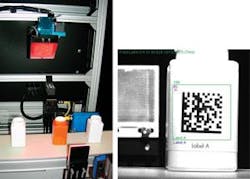RFID and vision team for pharmaceutical packaging
Shipping the correct product in the proper package is vitally important in the pharmaceutical industry. Should drugs be wrongly packaged, the patient could suffer serious medical complications. Thus, it is vital that each drug be properly packaged and labeled. However, since similar containers are often used by pharmaceutical vendors, proper labeling alone may not guarantee that the correct drug is placed in the package.
To overcome these limitations, suppliers of such containers are now embedding radio frequency identification (RFID) ICs into the containers before shipping them to pharmaceutical vendors. By programming these RFID tags with the type and strength of each drug and other relevant data, pharmaceutical vendors are providing their customers with a secure way of packaging the correct product in the proper package.
“RFID tags provide only one level of security,” says Brian Mack, sales engineer with CIVision (Aurora, IL, USA; www.civision.com), a manufacturer of machine-vision systems. “As well as reading the RFID tags, each package must be inspected to ensure that the information contained in the barcode label on the package corresponds with that of the RFID tag.”
CIVision has developed a pharmaceutical-packaging-inspection system, known as LOMAX RFID, using off-the-shelf machine-vision components (see figure). PC-based, the system inspects pharmaceutical packages as they move along a conveyor belt and into a specially designed housing that accommodates the lighting, RFID reader, and CCD cameras.
As containers enter this housing, a Cobalt HF reader from Escort Memory Systems (EMS; Scotts Valley, CA, USA; www.ems-rfidj.com) reads the information stored in the RFID tag. “Because tags emit signals with power levels on the order of millwatts, the reader’s sensitivity is paramount,” says Mack. “Developers must also take into account the receive noise, interference, and other effects that may increase a reader’s bit-error rate —the ratio of the number of bits incorrectly received to the total number of bits sent in a specified period. The EMS Cobalt HF reader, with –77-dBm sensitivity, provides enough power to activate a tag buried inside a pallet of stacked cases,” he says.
After the Cobalt HF reader checks each tag, data from each tag are transferred to the host PC over an Ethernet interface. To compare this information with the two-dimensional Data Matrix code located on each container, the barcode of each label is then read. As containers move along the conveyor, they are illuminated by a 4 × 0.5-in. FL201 area red LED front light from Metaphase Technologies (Bensalem, PA, USA; www.metaphase-tech.com), and an image of the package is captured using an A640 640 × 480-pixel gray-scale Gigabit Ethernet camera from Basler Vision Technologies (Ahrensburg, Germany; www.baslerweb.com).
To transfer captured images to the host PC, CIVision Engineers used a Solios GigE interface card from Matrox Imaging (Dorval, QC, Canada; www.matrox.com/imaging) that offloads the GigE Vision protocol and reconstructs images from transmitted data packets and passes the resulting image to the computer host. According to CIVision’s Mack, this frees up host resources and avoiding interrupt loading on the PC. Just as with its successful LOMAX NB (Neck and Bottle Inspection) CIVision used the Matrox Imaging Library (MIL) to capture and process these images(see Vision Systems Design, February 2007, p. 19).
Using MIL measurement functions, a region of interest around the barcode of each package is isolated and then read. These data are then compared with the data collected from the RFID system and the results of the comparison displayed on the operator’s console. Once again, the company used its CIVCore, a user interface with MIL low-level vision processing, to control the inspection process.
As each part emerges from the inspection station, packages where both barcode and RFID information can be rejected by pneumatically controlled actuators using a PLC programmed from the host PC. With the ability to inspect approximately 400 packages per minute on a single production line, the LOMAX RFID can be supplied in a number of different configurations, according to Mack. “Pricing of each system is dependent on a number of factors, including the type of product and the speed required,” he adds.

